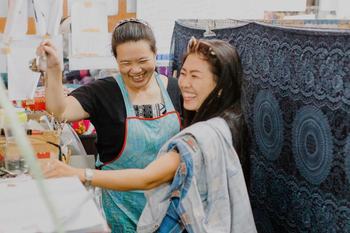
Table of contents
Healthy eating for beginners – 7 tips
Today I would like to share some tips and suggestions with you that can help you eat healthier. These tips are aimed at anyone who wants to eat healthier but doesn't yet know exactly how.
I, too, have only been eating consciously for a few years. Since then, I've learned a lot about what's good for my body - "clean eating" has made the biggest difference in my journey. Eating “clean” means consuming as unprocessed and natural foods as possible, such as vegetables, fruits, healthy fats or complex carbohydrates. Since then, not only have I been sick less often or tired after eating, but overall I just feel fitter and more awake.
Because this diet is so good for me, I would like to share my experiences and insights. The tips can serve as inspiration or as a “guide” to healthy eating. But please don't take these tips as the one right option. Just see what resonates with you and what you can and want to implement for yourself.
1. Acknowledge the process
As a “beginner” or newbie to nutrition, you should give yourself time and space to figure out what works for you and what is important to you. Often you are super motivated at the beginning and want to change everything at once. You quickly overwhelm yourself or put too much pressure on yourself. If nothing changes, you become demotivated and give up.
So please don’t think that you have to change everything from now on. You don't have to immediately cross all your favorite sweets off the list. You don't have to cook ahead for the entire week or eat vegan starting tomorrow. The whole thing is a process that you should recognize as such. Embark on a journey where you learn new things and gradually establish new habits.
Motivation is great, but allow yourself to slow down a little...
2. Healthy eating is individual
Healthy eating doesn't look the same for everyone - and it doesn't have to. You can eat healthy and be vegan. Or vegetarian. Or meat eaters. You can be a weightlifter or a yogi or a busy mom. You may want to eat three meals a day or six meals a day. We all have different daily rhythms, needs and requirements. So it's no wonder that all of our plates look different.
In my opinion, there is no one right diet. We all have to decide for ourselves what we think makes the most sense for us.
Nevertheless, I consider it sensible to eat unprocessed foods as often as possible. And of course, that we enjoy what we eat.
3. Cook for yourself as often as you can
Preparing your own food is one of the easiest ways to eat healthier. You get an overview of the ingredients you use and can decide for yourself what your food should look like in the end. You know exactly what you are working with and how your dish is composed.
The same applies here: give yourself time and don't put yourself under pressure. You don't have to cook every meal you eat. It's about getting into the habit of cooking more often than not cooking. So technically that's only 51% of the time .
Cooking for yourself can also help you appreciate your meals more. So you not only eat healthier when you cook for yourself - you also practice gratitude and mindfulness.

4. Quality over calories
Concentrating on counting calories is often associated with feelings of restriction and deprivation. That's no wonder: Our brain is constantly thinking about getting below a certain number at the end of the day and therefore focuses particularly on what it can't have, what it has to do without or what it needs to eat less of. In the long term, this really isn't particularly beneficial or healthy.
Instead, focus on the quality of the food you eat. Our brain now looks for ways and things to add to our diet that can improve the quality of the food. So it no longer works from a state of lack, but from a state of abundance. This way, nutrition can become more fun and more creative again. Our food not only tastes better, but also feels better.
5. Learn to read labels
By learning to read labels, you'll get an increasingly clear picture of what's going into your body. Look at the ingredients list of the products you buy. A well-known rule of thumb in this context is: 5 ingredients or less. You should be able to read, recognize and pronounce all the ingredients.
Of course, supermarket visits initially take longer. Personally, I always found it super exciting and informative to learn what I actually eat (and what strange things are in some products?! ).
I don't want to repeat myself over and over again, but the same applies here: you don't have to be “perfect”. One step at a time...
6. Avoid highly processed foods and artificial ingredients
This point is basically the core of “clean eating”. It's about enjoying food in its natural, original form if possible. Now you may be wondering: What exactly does “processed food” mean? Where does this begin?
Many healthy foods are lightly processed. These include, for example, quinoa, oatmeal or frozen vegetables. If the ingredient does not come directly from the farmer or field, it has been processed in some way. These lightly processed foods just mentioned are not the ones we are talking about here and that you should avoid. It's about foods that are highly processed and go through a whole lot of different steps in factories, for example, until they finally end up on our plates.
These products are often soaked in fats, sugar, salt or artificial ingredients and flavor enhancers. This causes them to lose their natural taste.
Our taste buds also suffer from this: They get so used to the high concentration of these flavor enhancers that at some point we no longer like the natural foods alone...
So if you notice that you are eating a lot of highly processed foods, start reducing them little by little. Your taste buds “reset” at some point and suddenly fruits taste sweeter again and vegetables taste less bitter. By the way, the craving for sweeteners and other addictive substances also decreases surprisingly quickly!
Unprocessed foods form the basis of clean eating. However, this does not mean that you cannot spice up or spice up your dishes!
7. Follow your hunger
Many of us are used to eating at certain times or according to a certain eating plan. This causes us to lose touch with our natural intuition. Our body is designed to let us know when it is hungry and needs new energy. So reconnecting with this incredibly clever system is the most natural thing we can do. This can save us a lot of effort: we no longer have to think so much and actively about what is best to eat and when, but we can simply feel it.
This also takes a bit of practice. If you think you're hungry, ask yourself, "Would I eat an apple or a cucumber right now?" If the answer is yes, you are probably really hungry. If you answer the question in the negative, you should wait and ask yourself the same question again after some time.
Hunger or thirst?
We often misinterpret thirst as hunger. So you can also drink a large glass of water first if you think you are hungry. You will find that you feel “full” and better afterward than if you had eaten something instead.
If you often feel super full and tired after eating, my last tip may help you: stop eating when you're full. That may sound banal. But we are all used to having an abundance of food available. Here's a second helping, there's a dessert... Very often we “overeat” and then feel exhausted or even disgusting.
While we eat, our body needs a little time (approx. 15 minutes) until we feel full. So eat slowly and mindfully. Eat a portion and then wait a while. Here, too, it's about connecting more with your body's own signals. It's a nice feeling to know what our body needs and what is good for it and when.
If you would like to find out more about the topics of healthy eating, mindfulness or sustainability, take a look here over.





























Leave a comment
This site is protected by hCaptcha and the hCaptcha Privacy Policy and Terms of Service apply.